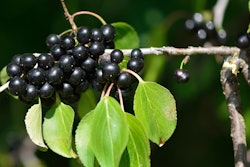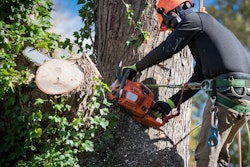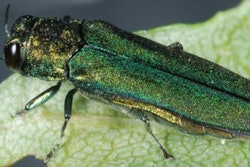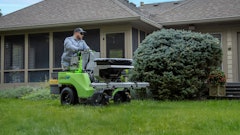
Managing noxious weeds on rangeland, forestland, open space, riparian and rights-of-way land is a challenging occupation that has legal ramifications.
In fact, the 1990 Colorado Noxious Weed Act enables county and city governments to implement management programs aimed at certain undesirable plants to reclaim infested acres and protect weed free land. The spread of these weeds has been exponential on and around disturbed lands. Information can be found about the national distribution of invasive species at the U. S. Department of Agriculture plants database.
Knowing the plant biology involved is important. Whether a plant is a monocot, dicot, winter or summer annual, biennial, simple or spreading perennial and which plant family the weed belongs to is essential information to a basic knowledge and understanding needed when managing noxious weeds.
An understanding of the vectors in which invasives spread and how we contribute to this spread when using construction and maintenance equipment can aid in minimizing the impact we have.
Responsible herbicide use is so important. If misused, the privilege of using these tools can be taken away. The label is the law: Recognize safe practices from initial herbicide recommendation through proper container disposal.
There is such an abundance of noxious weeds or alien invasive species that only a few can be covered here.
 Orange hawkweedISCMV.ca
Orange hawkweedISCMV.ca
Orange hawkweed
- Orange hawkweed grows in dense stands that are created by the prolific rhizome and stolon activity, though it is rare in the Intermountain Midwest.
- In the Northeast and Upper Midwest, there are monoculture acres as far as can be seen.
- If environmentally proper, try to target this plant using pyridine chemistry such as aminopyralid in the early to midbloom stage of growth.
- This usually occurs in early July along the Front Range foothills of Colorado.
Yellow toadflax
- Yellow toadflax has slender leaves and a late summer bloom like a snapdragon.
- Like other deep rooted spreading perennials, once land is infested with this weed, it will be impossible to eradicate and without periodic treatment can form a monoculture.
- It inhabits some of the most scenic natural landscapes on the continent.
- As with all weeds, early detection and rapid response in uninfested areas is the best defense against infestation.
Field bindweed
- This weed has been a localized and widespread issue in disturbed open space and pastureland.
- Tank mixes containing quinclorac have been highly effective in controlling this deep-rooted perennial weed, and there are many of examples of multiyear results.
Kochia and Russian thistle
- Members of the goosefoot family, these are mostly a problem in rights-of-way and industrial lands.
- Kochia is ubiquitous and can be hard to manage because of resistance to selective herbicides.
- Products containing fluoxypyr are most used these days.
- It is important to manage kochia while it is young (2 inches to 6 inches).
- Repeat treatments during the season may be needed. Kochia is resistant to 2,4-D.
- Mowing is the best option when the kochia has matured.
Japanese knotweed
- Japanese knotweed is common in the Pacific Northwest, but is a rare A List noxious weed in Colorado.
- Predrilling a pilot hole and injecting glyphosate has been used for control in the past.
- Foliar sprays of glyphosate or aminopyralid have been used successfully as well.
St. Johnswort
- This is another example of a weed brought to local Colorado front range foothills by ancestors.
- Sulfonylurea herbicides like chlorsulfuron can be very effective.
- When controlling noxious weeds, results are often measured months or the year after treatment.
- Sprays done the present year often don’t result in visible absence until the following year. Biocontrols have greatly reduced the impact of this invader over the last 60 years.
Hairy willow herb
- This species is a problem in wetlands of the region.
- Imported from Eurasia and North Africa, it can clog waterways creating monotypic stands.
- It increases bank erosion and displaces native vegetation. It can spread easily to undisturbed areas. As with other weeds, be careful not to mistake it for native plants from the same genus.
- Triclopyr and glyphosate have worked well to control it.
- Be sure to have your regulatory ducks in a row before applying anything.
Russian olive
- This is a noxious hardy, thorny, fast growing tree from Europe.
- This tree is rapidly replacing native riparian species and eliminating valuable nesting sites for birds.
- Russian olive removal and stump treatments can make for good late fall revenue for those brave enough.
- Triclopyr is used as a cut stump treatment immediately after the final cut is made being sure to cover the cambium layer and root flares.
 Tamarisk along the Colorado River Basin.Steve Dewey, Utah State University
Tamarisk along the Colorado River Basin.Steve Dewey, Utah State University
Tamarisk (also known as salt cedar)
- This was introduced from the Middle East by the Spanish in the 15th or 16th century.
- It is a phreatophyte that can reach the water table. It extracts copious quantities of salt that may impede the growth of other plants.
- They can lower the water table and therefore they are a real problem in areas of water impoundment such as the Colorado River Basin.
- Triclopyr and imazapyr are often used to manage tamarisk from summer through late fall.
- The Northern tamarisk beetle has done a good job defoliating the plants where it is established.




















